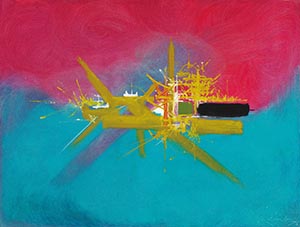Catalogue Note:
ROMANTIC EPIC
The famous painting merchant and historian Daniel Wildenstein (1917–2001) once told Mathieu, “Votre peinture montre une jeunesse et une évolution que seuls des artistes comme Titien et Monet ont accompliés” (Your paintings show a youth and an evolution that only artists like Titian and [Claude] Monet have accomplished.) Since Wildenstein was an expert on Monet, Édouard Manet, Gustave Courbet, and Paul Gauguin, this was extremely high praise! Georges Mathieu was born in 1921 in Boulogne-sur-Mer, France, on the opposite side of the channel from England, and grew up during the century’s great wars of 1919 to 1939. It was a time when France was conquering, prideful, and invasive, when the French colonial empire still enjoyed an era of prosperity. Born into a family of bankers, Mathieu's intense study of literature, law, and philosophy became the foundation of the high spirituality which marked his later works. He began his artistic journey in 1942, and thereupon abandoned a path in figurative art. In 1947, he held his first public exhibition. It was there that he broke down the geometric abstractions of Marevich and Mondrian and created his first lyrical abstract art. During Charles de Gaulle's presidency, Mathieu was given the title of “Calligrapher of the West” by André Malraux, the first French Minister of Culture.
Black, white, or red monochromic backgrounds were commonly utilized by Georges Mathieu in his early days. The vibrant monochromic backgrounds revealed the simple symbolic rhythm of liberty, harboring Zen imagery. Mathieu’s later works tended to be brighter and more varied. His style after the 1970s were especially imposing with an extraordinary flair. In the 1907s, Mathieu focused heavily on the dynamical balance on canvas, materializing combinations of color blocks in the center of canvases. The work ''Orestide'' harbors Mathieu’s typical colors with Turkish blue and magenta interlaced into two spaces. The white, gold and black color blocks are juxtaposed in the center of the picture, forming a brilliant style from the classical Greco-Roman period.
1976 marked the 30th year of Mathieu’s lyrical abstract paintings, and the Picasso Museum in Paris held a commemorative exhibition to recognize his contribution. In the same year, Mathieu created a series of Greek-themed works that carry the structural element of Greek columns. The work ''Orestide'' is one of them. Orestide is the name of an ancient Greek region which belonged to the ancient Greek period of Epirus and Macedonia. With a passion for history, Mathieu, a painter of noble blood illustrates romantic rhetoric and themes of tribute, providing new interpretations and sentiments of history. Mathieu’s magnificent paintings are like lightning and flames inundated with stunning symbols and signs. Mysterious and blazing, his paintings harbor a bright emotional intensity.
In 1976, he was selected to inherit Alfred Giess’ position as a member of the Académie Française. Mathieu’s friendly relationship with the Ministry of Culture allowed him to be somewhat viewed as the official artist representative of the 1970s; and it wasn’t until Mitterrand took the office in the 1980s that the right wing Mathieu faded from the public eye. Mathieu knew how to utilize the rise of the media of his day to boldly convey his artistic ideologies as well as his misgivings towards the systems of contemporary society. His every word was paid close attention. Along with Bernard Buffet, another member of the Académie Française, he was the most prominent abstract and figurative artist of his time.
Mathieu’s exhibition steps were all around the world, most of his private collectors came from Europe or North America. MoMA, Guggenheim Museum, Centre Pompidou, Museum of Contemporary Art Tokyo and almost hundred museums collect Mathieu’s artworks. His first retrospective exhibition was held in 1963 in Musée de la Ville de Paris, and in Grand Palais, 1978, in Jeu de Paume Museum, 2002.
